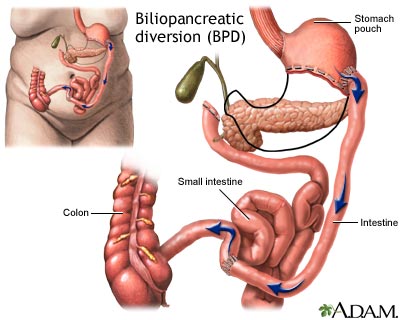Biliopancreatic diversion (BPD)

Malabsorptive operations, such as biliopancreatic diversion (BPD), restrict both food intake and the amount of calories and nutrients the body absorbs.
In a BPD procedure, portions of the stomach are removed. The small pouch that remains is connected directly to the final segment of the small intestine, completely bypassing the upper part of the small intestines. A common channel remains in which bile and pancreatic digestive juices mix prior to entering the colon. Weight loss occurs since most of the calories and nutrients are routed into the colon where they are not absorbed.
Update Date: 8/17/2011
Updated by: Ann Rogers, MD, Associate Professor of Surgery; Director, Penn State Surgical Weight Loss Program, Penn State Milton S. Hershey Medical Center. Also reviewed by David Zieve, MD, MHA, Medical Director, A.D.A.M., Inc.
Notice: The information provided herein should not be used during any medical emergency or for the diagnosis or treatment of any medical condition. A licensed physician should be consulted for diagnosis and treatment of any and all medical conditions. Call 911 for all medical emergencies. Links to other sites are provided for information only -- they do not constitute endorsements of those other sites. Copyright 1997-2012, A.D.A.M., Inc. Any duplication or distribution of the information contained herein is strictly prohibited.
